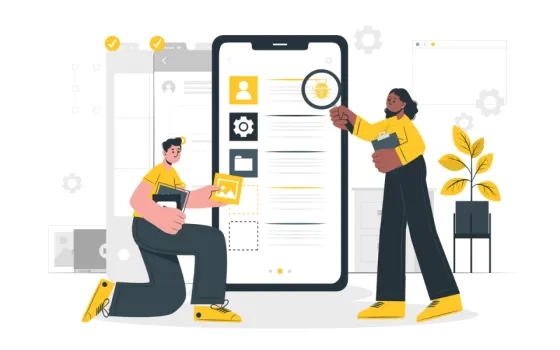mobile app development
1. Introduction to Mobile App Development
Mobile app development has become a crucial aspect of modern technology and business strategies. With the exponential growth of smartphones and the increasing demand for mobile applications, businesses and individuals are recognizing the immense potential and benefits that mobile apps offer. From enhancing user engagement to providing new avenues for marketing and revenue generation, mobile app development has opened up a world of opportunities. In this article, we will explore the fundamental concepts of mobile app development, delve into the key considerations and steps involved in the process, discuss the various frameworks available, highlight best practices for designing user-friendly apps, and explore the future trends and innovations in this dynamic field. Join us as we embark on this exciting journey of mobile app development.
Mobile App Development: Revolutionizing the Digital Landscape with Wit and Ingenuity
1. Introduction to Mobile App Development
1.1 The Rise of Mobile Apps
In a world where smartphones have become our constant companions, mobile apps have taken center stage. These tiny icons on our screens have transformed the way we live, work, and play. From ordering food to hailing a ride, mobile apps have revolutionized our daily routines and made life a whole lot more convenient.
1.2 Importance of Mobile App Development
With more than three billion smartphone users worldwide, mobile app development has become a crucial aspect of any business strategy. Whether you're a small startup or a multinational corporation, having a mobile app can significantly impact your brand's visibility and customer engagement. It's a way to connect with your target audience and provide them with seamless experiences that keep them coming back for more.
2. Key Benefits and Opportunities of Mobile App Development
2.1 Enhanced User Engagement and Experience
Mobile apps offer a personalized and intuitive experience for users, allowing them to interact with your brand in a more engaging way. Through push notifications, in-app messaging, and tailored content, you have the power to keep users hooked and foster long-term relationships.
2.2 Increased Brand Visibility and Recognition
A mobile app puts your brand right at your customers' fingertips, ensuring that you're always just a tap away. Having a recognizable app icon on their home screen serves as a constant reminder of your presence, making your brand more accessible and memorable.
2.3 Access to a Wider Audience and Market
Mobile apps transcend geographical boundaries, allowing you to reach a global audience. With the power of app stores, you can introduce your brand to potential customers worldwide and tap into untapped markets, expanding your business horizons like never before.
3. Essential Steps in Mobile App Development Process
3.1 Defining App Objectives and Requirements
Before diving into development, it's crucial to define the objectives and requirements of your app. What problem will it solve? Who is your target audience? Answering these questions will guide your development process and ensure you stay focused on delivering the right solution.
3.2 Wireframing and Prototyping
Wireframing and prototyping are like the blueprints of your app. They help you visualize the user flow, layout, and features before investing time and resources into development. Building a solid foundation ensures a smoother development process.
3.3 UI/UX Design and Development
Creating a visually appealing and user-friendly interface is paramount in mobile app development. A clean and intuitive design combined with seamless navigation keeps users engaged and maximizes the chances of success.
3.4 Backend Development and Integration
While the user interface is what users see, the backend is the brains behind the app. It involves developing the server, database, APIs, and integrating third-party services to ensure your app functions smoothly and securely.
3.5 Testing and Deployment
Thorough testing is crucial to identify and fix any bugs or usability issues before launching your app. Once you're confident in its performance, it's time to deploy your app to the app stores, making it available for download by eager users.
4. Choosing the Right Mobile App Development Framework
4.1 Native App Development
Native app development allows you to create apps specifically for a certain platform, such as iOS or Android. It leverages the unique features and capabilities of each platform, providing a seamless and optimized user experience.
4.2 Hybrid App Development
Hybrid app development combines the best of both worlds by using web technologies (like HTML, CSS, and JavaScript) wrapped in a native shell. It allows developers to create apps that run across multiple platforms, saving time and effort.
4.3 Cross-platform App Development
Cross-platform app development frameworks, like React Native and Flutter, allow building apps that can run on multiple platforms with a single codebase. It offers the advantage of code reusability, reducing development costs, and time to market.
Mobile app development is an exciting and ever-evolving field that opens up endless possibilities. By harnessing the power of mobile apps, businesses can thrive in the digital landscape and connect with their audience on a deeper level. So, whether you're a tech enthusiast or a business owner looking to stay ahead, mobile app development is a path worth exploring. Enjoy the journey of creating amazing experiences and let your app shine on screens around the world!5. Key Considerations for Designing User-friendly Mobile Apps
5.1 Simplified and Intuitive User Interface
When it comes to mobile apps, simplicity is key. Users want an interface that is easy to navigate and understand without needing a manual or a degree in rocket science. Think about it, the last thing anyone wants is to get lost in a maze of convoluted menus and confusing icons. So, make sure your app's user interface is clean, straightforward, and intuitive. Your users will thank you for it.
5.2 Responsive and Adaptive Design
Mobile devices come in all shapes and sizes, and your app should be able to adapt to them. Responsive and adaptive design ensures that your app looks great and functions properly, regardless of whether it's on a tiny smartphone or a jumbo tablet. Nobody wants a squished or stretched app that looks like it's been through a funhouse mirror. So, embrace the magic of responsive and adaptive design to give your users the best experience possible.
5.3 App Performance and Loading Speed
Impatience is a virtue. At least when it comes to mobile app users. People want their apps to load quickly and perform flawlessly. If your app takes forever to load or crashes more often than a clumsy juggler, users will flee faster than you can say "buffering." So, optimize your app's performance and loading speed to keep your users happy and engaged. Remember, a snappy app is a happy app.
5.4 Accessibility and Localization
Inclusivity is important, even in the world of mobile apps. Your app should be accessible to users with disabilities, offering features like text-to-speech, voice control, and adjustable font sizes. Additionally, don't forget about localization. The world is a diverse place, and your app should speak the language of your global audience. By making your app accessible and localized, you'll be opening the doors to a wider user base and showing that you care about reaching everyone.
6. Strategies for Marketing and Monetizing Mobile Apps
6.1 App Store Optimization (ASO)
So, you've built an amazing app, but how will people find it in the vast sea of apps out there? That's where App Store Optimization (ASO) comes in. By optimizing your app's keywords, title, screenshots, and description, you can increase its visibility and attract more organic downloads. Think of ASO as the magical potion that boosts your app's chances of being discovered in the app store jungle.
6.2 Social Media and Influencer Marketing
These days, social media is like the cool kid on the block. And if you want your app to be seen by the masses, you need to hang out with the cool kids. Leverage social media platforms to create buzz around your app. Engage with your target audience, share interesting content, and collaborate with influencers who can help spread the word. With the power of social media on your side, your app will be the talk of the town in no time.
6.3 In-app Advertising and Freemium Models
Money makes the world go round, or so they say. If you're looking to monetize your app, in-app advertising and freemium models are two popular strategies. In-app advertising allows you to display ads within your app, generating revenue from clicks or impressions. On the other hand, freemium models offer a basic version of your app for free, with additional features available for a price. Both strategies have their pros and cons, so choose the one that aligns with your app's goals and target audience.
7. Best Practices for Mobile App Testing and Quality Assurance
7.1 Functional Testing and Bug Fixing
Nobody likes a glitchy app that crashes more often than a clumsy clown on stilts. That's why functional testing is crucial. Test every nook and cranny of your app to ensure it works as intended. And when bugs inevitably appear, squash them like the brave exterminator you are. Regular testing and bug fixing will keep your app running smoothly and your users smiling.
7.2 Performance Testing and Optimization
Performance is the name of the game. You want your app to be lightning-fast and efficient, like a cheetah on Red Bull. Run performance tests to identify bottlenecks and optimize your app's speed and responsiveness. Nobody wants to wait for ages while your app loads or stutters like a broken record. So, give your users the gift of high-performance and they'll be forever grateful.
7.3 Security and Privacy Testing
In the age of data breaches and privacy concerns, security is non-negotiable. Your users trust you with their personal information, so it's your duty to protect it like a fiercely loyal bodyguard. Conduct thorough security and privacy tests to ensure your app is a fortress of protection. From encryption to secure authentication, leave no stone unturned when it comes to safeguarding your users' data.
8. Future Trends and Innovations in Mobile App Development
8.1 Augmented Reality (AR) and Virtual Reality (VR)
Get ready for a virtual adventure because augmented reality (AR) and virtual reality (VR) are the next big things in mobile app development. AR lets you superimpose digital elements onto the real world, while VR immerses users in a completely virtual environment. From gaming to education to e-commerce, AR and VR have the power to revolutionize the way we interact with mobile apps. So, put on your futuristic goggles and get ready for a mind-blowing experience.In conclusion, mobile app development has revolutionized the way businesses and individuals interact with technology. As the demand for mobile apps continues to grow, it is essential to stay updated with the latest trends and technologies in order to create successful and user-friendly applications. By understanding the key benefits, following the essential steps, and implementing effective marketing and testing strategies, developers can create impactful mobile apps that cater to the needs and preferences of their target audience. The future of mobile app development holds even more exciting possibilities, such as augmented reality and virtual reality, which will further enhance the user experience. Embrace the world of mobile app development and unlock endless opportunities in the digital landscape.
FAQ
1. What is the importance of mobile app development for businesses?
Mobile app development is crucial for businesses as it allows them to enhance user engagement, increase brand visibility, and access a wider audience. With mobile apps, businesses can provide a seamless user experience, offer personalized content, and create new revenue streams through in-app purchases or advertisements.
2. What are the key steps involved in the mobile app development process?
The mobile app development process typically includes defining app objectives and requirements, wireframing and prototyping, UI/UX design and development, backend development and integration, and finally testing and deployment. Each step is essential for creating a successful and functional mobile app.
3. Which mobile app development framework should I choose?
The choice of a mobile app development framework depends on various factors such as project requirements, budget, and target audience. Native app development offers optimal performance and access to device-specific features, while hybrid and cross-platform frameworks provide a cost-effective and efficient way to target multiple platforms simultaneously. It is important to analyze the specific needs of your project and consult with developers to make an informed decision.
4. How can I effectively market and monetize my mobile app?
To effectively market and monetize your mobile app, consider implementing app store optimization (ASO) techniques, leveraging social media and influencer marketing, and exploring in-app advertising or freemium models. It is essential to understand your target audience, identify key marketing channels, and continuously analyze and optimize your app's performance to maximize its success in the market.

















